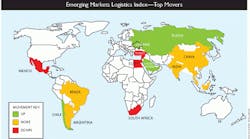The acronym BRIC came into popular usage about a decade ago as an easy way to refer to the four fastest emerging markets: Brazil, Russia, India and China. Based on research conducted by analyst firm Transport Intelligence, it might be time to come up with a new acronym to reflect the growth of several other countries that have their sights set at becoming logistics trade hubs.
According to the Emerging Markets Logistics Index, sponsored by logistics company Agility, Indonesia has already nudged Russia aside to become the fourth most attractive emerging market (largely for its low-cost manufacturing capabilities), out of the 39 countries studied. Other countries quickly climbing the index are Saudi Arabia (No. 6), Chile (No. 10) and Oman (No. 14).
"It is clear that emerging markets are playing an increasingly important role in global supply chain strategies as manufacturers look to the next wave of low-cost production locations," says John Manners-Bell, CEO of Transport Intelligence. "However, investors need to be cognizant of the specific challenges which exist in each market as well as the opportunities." The index, he explains, is designed to help companies differentiate between those markets which offer immediate potential and those which will take a significant amount of time to develop.
For instance, Brazil, a traditional BRIC nation, ranks third on the list of most attractive markets, but in terms of its potential as a logistics hub, it ranks third from last, largely due to security issues and a lack of adequate infrastructure. In effect, then, while Brazil is attractive due to its size and growth, it's not viewed nearly as highly from the standpoint of actually doing business in the country.
Conversely, Chile, another South American country, has moved into the index's top 10 for overall attractiveness. Based on the survey results, Chile benefits from numerous trade agreements that enable good access to foreign markets for its exporters. In the index's ranking of connectedness (i.e., liner shipping connectivity, airport density, customs efficiency and infrastructure strength), Chile ranked No. 3, behind only the UAE and China.
Two Middle East countries, Saudi Arabia and Oman, moved up four places in the standings. Saudi Arabia was cited for the amount of foreign direct investment coming into the country, while Oman's improved score was helped by improvements in its airport infrastructure as well as security. Egypt, on the other hand, dropped four places in the rankings (to No. 13) due to concerns about crime, violence and terrorism (and note that the rankings were compiled before the recent uprising in Egypt).
The African continent is still viewed as a potential alternative to the Asia-Pacific region as a future manufacturing hub -- an lower-cost low-cost center, if you will -- but much work remains to be done to upgrade its infrastructure and security measures for the Western world to take Africa more seriously for offshore activity.
Emerging Markets Logistics Index
1. China
2. India
3. Brazil
4. Indonesia
5. Russia
6. Saudi Arabia
7. Mexico
8. Turkey
9. United Arab Emirates
10. Chile
Source: Transport Intelligence
See Also:
• Congested Highways
• A Supply Chain Management Guide to Business Continuity



